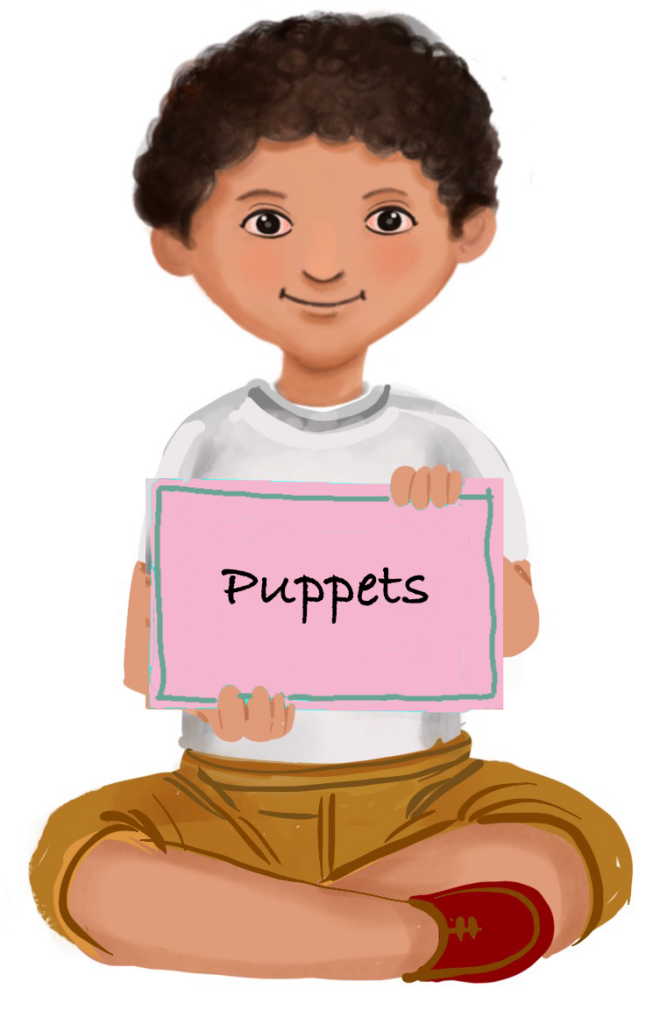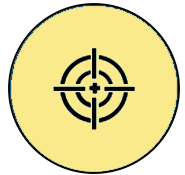
Rabbit
 Objective
Objective
To guide teachers in creating a puppet of a Rabbit for story-telling and other educational purposes.
Estimated time to create the Rabbit Puppet
30 to 45 Minutes
Materials required for creating Rabbit Puppet
- White Hard Chart paper
- Googly Eyes
- Pencil
- Orange sketch
- Glue drops or Fevicol
- Scissors
Preparation for Activity
Keep all materials ready in advance. If you are using hot glue instead of Fevicol, ensure it is suitably heated and ready for use.
Procedure
- This rabbit puppet is designed to be used both as a finger puppet and as a free-standing figure on a table.
- Depending on the desired size of the rabbit, take a piece of rectangular shaped white chart paper and fold it in half.
- On one side of the folded paper, draw the outline of the rabbit’s body. Cut along the outline using scissors. You will get two identical pieces (A) for the front and back of the rabbit’s body.
- Take another small rectangular piece of chart paper and fold into half. Holding the folded edge upward, place this piece over one of the (A) pieces. Cut the paper to match the shape of the belly and legs of piece (A). Let this piece be called (B).
- While holding the folded edge of the piece (B) upwards and aligning it with the belly and legs, attach the two body pieces (A) on either side of (B) using fevicol.
- Now, apply fevicol along the top edge of front and back pieces (A) and join them.
- Take another piece of white chart paper, fold it in half. Draw and cut out the shape of the ear. Colour the middle part using an orange sketch pen.
- Attach the ears on either side of the head using fevicol.
- Fix googly eyes just below the ears on both sides using fevicol.
- To operate the puppet with a finger, attach a small strip of paper connecting the front and back belly parts.
- Allow the glue to dry for a few minutes; the puppet is now ready.
- It can be used both as a finger puppet and as a standing figure on a table.
Step by Step Pictures to create the puppet
Important Tips
- For this type of puppets, it is better to use thick chart sheets so that they are durable and can be used many times.
- Eyes can also be drawn using a black marker instead of using Googly eyes.
- Wedding cards or book covers can be good alternatives to drawing sheets.
- Reference images from drawing books or the internet can be helpful while designing the puppet.
- While creating the puppet, try to replicate the character illustration from the children’s textbook. Once the puppet is ready, refer to it by the character’s name from the textbook. This helps children connect with the content and improves recall.
- The teacher should use the puppet at an appropriate time, perhaps while narrating the story in a funny and humorous way. Intentional mistakes can also be made to encourage children to correct them, making the session more interactive and engaging.
Precautions
Precautions to be taken while manipulating finger puppets:
- Always keep the puppet’s face directed towards the audience.
- The Puppet Master’s focus should remain on the puppet at all times.
- Only the puppet that is ‘speaking’ should be animated; all other puppets should remain still.
Troubleshooting:
- While making the paper pipe, ensure it matches the exact size of the finger you will be using. This helps to move the puppet properly.
- Use a cutter carefully to make clean, precise holes.
- The holes should match the size of your fingers. If the hole is too large, the puppet won’t stay upright on your finger. If the hole is too small, it will be difficult to insert your finger.
 Notes to the Teacher
Notes to the Teacher
Puppets can be effectively used in the classroom to help children understand and express emotions. They are also valuable tools for teaching rhymes, songs, stories and more.
In addition to enriching learning experiences, using puppets supports the development of motor skills such as hand-eye coordination. They also enhance communication and social skills, improve focus and concentration, and help reinforce concepts and values in an engaging way.
Using the Learning Teaching Material
The teacher can demonstrate a puppet show as an example. Students can then be encouraged to create their own puppets and present a puppet show in the classroom.
Video: How to use Learning Teaching Material
| Source and Attribution of images All images used in the above Assets and Aids are originally created. |
| This digital material has been developed by the Sri Sathya Sai Vidya Vahini Inclusive Education Project, a unit of Sri Sathya Sai Central Trust, Prasanthi Nilayam, as a collaborative offering in the service of our nation. |